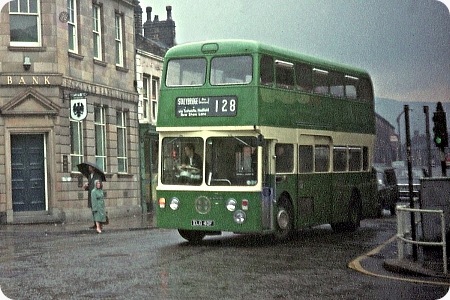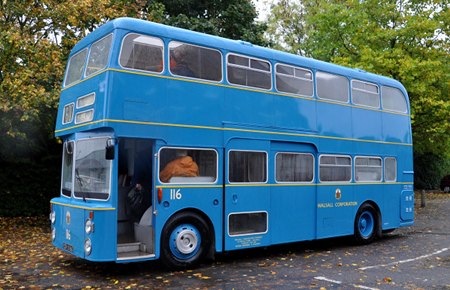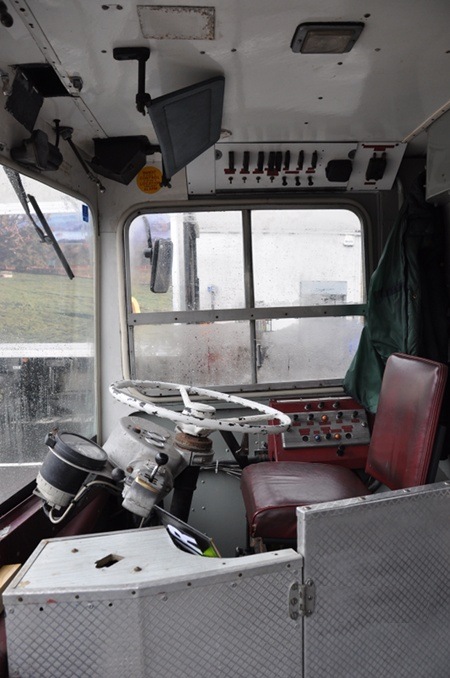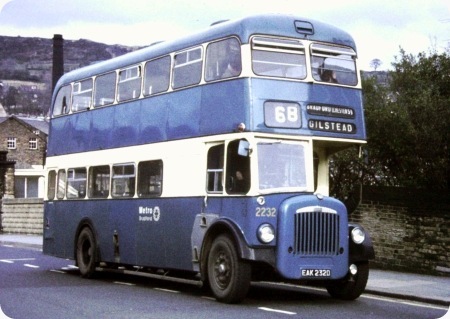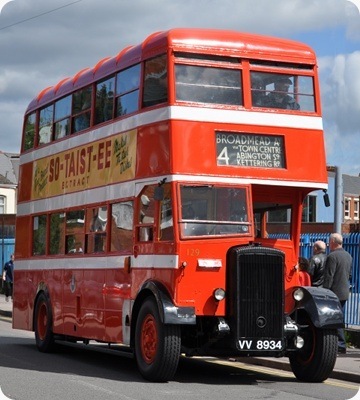 Copyright Ken Jones
Copyright Ken Jones
Northampton Corporation
1945
Daimler CWD6
Duple H30/26R
VV 8934 is a Daimler CWD6 with Duple Utility body and is seen in service during Coventry City Transport centenary event in May this year (2012). The vehicle was new to Northampton Transport in 1945 as fleet number 129. Restoration was completed in 2011 and I think this is the only Daimler with utility body left running. It is owned by a member of the Lincolnshire Vintage Vehicle Society and should be at their event in November.
Photograph and Copy contributed by Ken Jones
07/10/12 – 08:46
What about the Huddersfield one, masquerading as a London vehicle which is (was?) owned by Stephen Morris?
David Oldfield
07/10/12 – 10:24
The question is whether this is the only (rare) CWD6 in preservation: The London/Huddersfield CW is an A, I think.
Joe
07/10/12 – 10:35
Huddersfield 217 (CCX 777) is indeed a CWA6. It too was new in 1945 and also carries a Duple body but of the lowbridge variety. It appears in Huddersfield, PMT and London Transport liveries on this posting.
Eric Bawden
07/10/12 – 11:39
You can’t make a silk purse out of a sows ear, but Corporate livery ‘experts’ would do well to take note, a good simple livery with no gimmicks will enhance the appearance of even the most basic of vehicles, and this one could hold its head high alongside any of today’s eyesore’s
Ronnie Hoye
07/10/12 – 14:48
Probably the only preserved CWD6, but as well as the Huddersfield lowbridge example, there is, or was, a highbridge Duple CWA6 from Douglas Corporation in preservation. See the cover of Alan Townsin`s TPC book on utility buses.
John Whitaker
07/10/12 – 18:03
This is, to my mind, a handsome vehicle. This is what a bus should look like! A fantastically good restoration…all credit to those responsible who have done a superb job. I know absolutely nothing about these vehicles, but having driven RT’s and RML’s etc on LT, and LKH’s on E.C.O.C., this photo only makes me wish I could have driven one of these as well !!—with pride….
Norman Long
07/10/12 – 18:22
Another Daimler CWD6 in preservation is Aberdeen Corporation 155. The bus currently resides at the Scottish Vintage Bus Museum at Lathalmond in Fife.
155 is now painted in the earlier livery of dark green and white.
Stephen Bloomfield
08/10/12 – 08:23
Magnificent, and to think that the modern equivalent will be in shades of pink and grey. YUK!
Pete Davies
08/10/12 – 11:35
I have come across a short video of this vehicle and it can be seen and heard from the OB Sounds page
Chris Hebbron
Quick link to the OB Sounds page and it should take you directly to the clip.
08/10/12 – 11:38
To confirm that CWD6 Northampton 129 will be in service at the LVVS Open Day on Sunday November 4th. Please see www.lvvs.org.uk for the list of vehicles in service. May be as many as 35. A great day out.
John Child
10/10/12 – 13:22
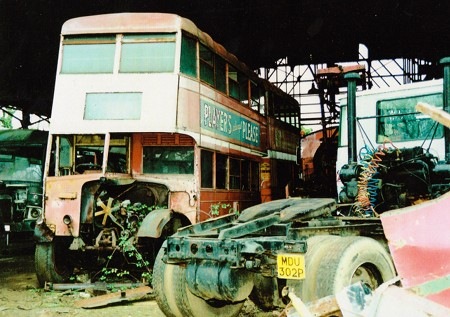
Copyright John Child
John Child thought you maybe interested in this picture as a before and after shot pertaining to my shot above. The picture was taken by John at Molesworth in 1990 prior to restoration. Makes an interesting comparison to my shot don’t you think?
Ken Jones
05/11/12 – 17:00

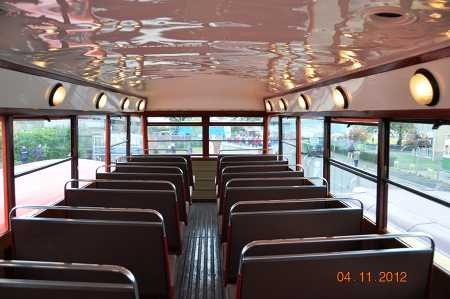
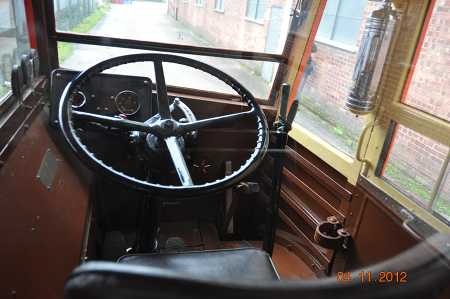
At Lincoln yesterday I was given access to photograph interior of VV 8934 without the crowds and a private trip round the block thanks to the owner John Childs and the crew of the vehicle.
Ken Jones
06/11/12 – 15:26
I was also at the LVVS do at Whisby Road, and rode upstairs on an almost full VV 8934. I imagined that progress would be fairly sedate, but thanks to the fine mechanical condition of this bus, matching its immaculate bodywork, and to the skill of the man in the cab, it positively flew along. Gearchanges and braking were wonderfully smooth and the sound effects a real delight.
Thames Travel, based at Wallingford, Berks, who run a very good if tightly-timed service between Oxford and Reading, are just about to get rid of some MCV single deckers. It’s almost unbelievable that these tinny, bouncy, deafening vehicles with their cramped 27" seat spacing, are 6 decades newer than the magnificent Northampton Daimler.
The standard of restoration and driving of every vehicle I rode on was very impressive, but their original design has hardly been improved on. I admit that heaters are better today and seats are wider, and that low floors and kneeling suspension now make buses available to all—a piece of real progress, that—but the overpowered engines, fierce brakes and inescapable din from air-circulating systems assault the senses from all sides.
The LVVS day was like a return to sanity!
Ian Thompson
07/11/12 – 06:54
Be careful Ian – the thought police will get you!
Stephen Ford
07/11/12 – 08:46
S*d the thought police, Stephen, I’m with Ian.
David Oldfield
07/11/12 – 10:25
I agree entirely, Ian. Things to add to the "comforts" of modern bus travel are moulded plastic passenger seats, snatching retarders and howling differentials. Why are back axles so much noisier these days?
Roger Cox
07/11/12
All these, plus the noisy overrun on the engine when changing down when slowing!
Chris Hebbron
08/11/12 – 07:13
Can I dare to say that the whole design of modern buses is flawed: the rear engine is yards away from the driver, and gets abused by the driver’s lack of sensitivity at this distance, and by the remoteness of the controls. The weight at the rear seems to make them unmanageable in ice and snow. If you stand to leave, the braking pitches you forward, whereas it is safer to be pulled back. Why o Why, when passenger numbers are falling, do we go for megabuses all the time? They clog up lanes and streets. Just a few thoughts on why that Daimler doesn’t seem ridiculous at all. Bring back the Q!
Joe
08/11/12 – 14:53
Joe, I entirely agree. The whole point of front entrance/rear engine seems to have been to facilitate one man operation. (The thought police will get ME for that!) But the effect was to give a thumping great bus the balance characteristics of a caravan. I recall a seasick-making journey from Ipswich to Hadleigh 30 years ago on an ECOC Bristol VR (by no means the worst offenders in the soggy suspension stakes). It was like a fairground white knuckle ride. Then also, using high capacity buses to reduce frequency while maintaining the appearance of service provision expressed as seats per hour makes the service less attractive, and for many people totally useless – and this when everyone is used to the infinite flexibility of getting into a car when they want to. Add to that the long delays at each stop while passengers fumble for their money or pass, and it is obvious why busy and impatient people regard the bus as transport of the last resort. I am a great fan of the continental "honesty" system for fare collection on city networks – passes or books of tickets bought at newsagents, and self-validated on board, with flying squads of inspectors charging about 25 times the standard fare for evasion. This removes time-consuming revenue collection from the driver and keeps the bus moving. It also cancels the need for a bus design with passenger access alongside the driver. (In other words, the wheels can revert to the front instead of being somewhere in the middle where they give the seesaw effect.) In some of our rougher cities it would be a positive advantage for the driver to be in his own secure cab, and not to be exposed to the verbal and physical abuse of the great unwashed public.
Well, that should be good for a few rejoinders!
Stephen Ford
09/11/12 – 07:44
Stephen there is much sense in what you say about fare collection although the dear "Public" are probably rather less honest than in Europe..well they used to be perhaps!
I would make things even more simple..within city boundaries defined clearly, I would make all bus travel completely free. How?…we squander tens of millions on "surveys" and "planning" trying to make badly flawed ideas work here in Bristol. Just now £20M has been chucked away after scrapping plans for a "bendy bus" network that is now thought to be better if operated by..single deck buses 36" long…that’ll be a stroke of genius! So, rather than continue to fumble about any more, just make travel free and use the funds lost in trying to get people to catch the bus to make using one a VERY good idea. The operating costs being taken care of from Government funding currently set aside for a multitude of "solutions".
Free things always work. Greater minds than mine on here will have a better understanding on how possible this is but it would be a big help if free say 6 – 9 am and 4-7pm..less cars, less pedal cycles ridden by madmen, less traffic hold ups and a younger passenger base becoming more used to buses than most of us older bods for whom the car is vastly preferable and who don’t fancy standing in the rain for ages waiting to ride home sat next to a loony with a cold!
Now…anyone think the idea has..wheels??
Richard Leaman
09/11/12 – 16:57
I think the maths of the Continental honesty system goes like this : there will be some people who will never bother to get a ticket. OK, that doesn’t matter so long as they get caught about one journey in every 25 – because the fine will reimburse all the previous unpaid journeys.
Stephen Ford
10/11/12 – 06:42
I can remember the first Atlanteans with the Northern General Group, I would have been about 14ish at the time, anyway, about two or three weeks after they came into service I was speaking to a friend of my Dads who was a driver, I asked him what he thought of them and he said he hated them, why? I asked, and he replied that as well as being an abortion to drive, as soon as you pull up at a stop and open the doors all you get is, where’s the bus in front, you’re early/late, do you, don’t you, what time, how long, is it, will it, wont it, what bus goes here, how do I get there, and after 20 odd years on buses he finally knew what conductors were moaning about.
Ronnie Hoye
10/11/12 – 06:43
In the past, some British operators used to have honesty boxes on buses and trams. Glasgow was one, and, I think, Brighton Corporation. I wonder who supervised the emptying of these receptacles. One of the reasons why London Country (for one) discontinued the use of fareboxes was the opportunities they afforded for unauthorised access to the contents of the coin vaults by the designated removal staff during the small hours.
Roger Cox
10/11/12 – 09:17
Huddersfield Corporation/JOC also had honesty boxes certainly until the late 60’s.
John Stringer
10/11/12 – 10:18
Of course, inspectors are few and far between nowadays, too, although one did get on my bus the other day and did his stuff thoroughly. As for abroad, I do recall, about 8 years ago, travelling on a Lille tram and, at one point notably as we stopped at a college/Uni, a hoard of traffic staff blocking the tram doorways and checking for evidence of valid travel for those descending (mainly students), several offenders being caught. Then, a couple stayed aboard to the next stop, checking the remainder of passengers and catching about four more. I recall they caught quite a few offenders! There were no honesty boxes, but it’s doubtful if they’d have worked there!
Chris Hebbron
10/11/12 – 10:22
I am by no means certain but I think Huddersfield’s honesty boxes ceased to be fitted to new buses in 1967 with the arrival of the first Fleetlines but as far as I can remember those already fitted stayed with the bus until it was withdrawn.
Perhaps someone who remembers the Huddersfield PD3A’s in service with OK can tell us if they were still fitted then?
Eric Bawden
10/11/12 – 11:30
Nottingham City Transport had them too – though I don’t ever remember seeing anyone put anything in them. I guess the thought was "If the conductor hasn’t collected the fare by the time I reach the platform to get off – tough!"
Stephen Ford
11/11/12 – 07:34
Grimsby-Cleethorpes used them, the only time I ever saw them being used was when my driver inadvertently left me at Riby Square and I had to be taken to the bus by patrol van.
Philip Carlton
16/03/17 – 06:28
I look forward to conducting Northampton Daimler 129 again on the LVVS spring running day Sunday 16th April 2017. The owner is a Mr. John Child and all tickets issued are Child tickets for obvious reasons. One little known fact about the war time utility buses is that they do not have a conductor platform repeater bell. When the motor is running the conductor cannot hear the bell ring in the drivers cab so he has to give the thumbs up to indicate he heard the bell. Northampton Corporation never got around to installing a bell post war. It is a joy to conduct this bus which is in first class condition.
Bob Perrin
04/04/17 – 07:23
No, it is not the only CWD in preservation. Aberdeen 155 (BRS37) is a 1945 example, fully restored at SVBM at Lathalmond, near Dunfermline.
Mr Anon
 Vehicle reminder shot for this posting
Vehicle reminder shot for this posting
24/04/17 – 07:15
As a kid growing up in Northampton with relatives working on the buses I achieved a goal of every bus in service. That included fleet # 129.
John Cummins
